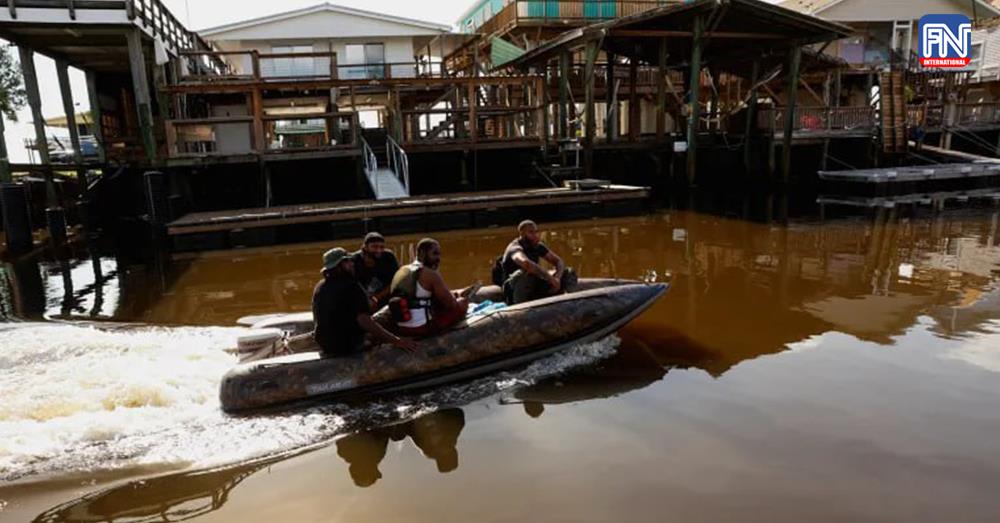FLORIDA, Aug 30 (Aljazeera) - At least three people have been killed as the Hurricane Idalia slammed into the Florida coastline on Wednesday morning, sowing a path of destruction as it tore northward to Georgia and South Carolina.
The Florida Highway Patrol described the two of the deaths as separate, rain-related incidents.
In one case, a 59-year-old man appears to have lost control of his truck during “extremely rainy conditions” in Gainesville, Florida, crashing into a ditch, then a line of trees.
The second incident occurred in Pasco County. A 40-year-old man there was driving “too fast for conditions” and struck a tree, the highway patrol said.
A third person was killed in Valdosta, Georgia, as he attempted to dismantle a fallen tree, according to Lowndes County Sheriff Ashley Paulk.
The tree was blocking a roadway, and as the victim was cutting it, a second tree fell, killing the man and injuring another.
Idalia made landfall in Florida as a powerful Category 3 storm, after briefly strengthening to a Category 4 — the second highest level in the five-tier wind scale.
The cyclone had intensified rapidly. In less than a day, it had gone from a Category 1 storm into a major hurricane, leading the four states in its path — Florida, Georgia, South Carolina and North Carolina — to declare states of emergency.
Experts believe Idalia was supercharged by the warm waters off of Florida’s coast, where surface temperatures were as hot as 38 degrees Celsius (101 degrees Fahrenheit) in July.
By Wednesday afternoon, after hours churning over land, Idalia was downgraded to a tropical storm. But experts warned that the storm system was no less deadly.
“While Idalia has lost the designation of a hurricane, it is no less risky for the people in the path of this system,” Deputy Director Jamie Rhome of the National Hurricane Center said in a livestream broadcast.
Rhome described a “heavy shield” of rain and heavy wind as Idalia pushed toward South Carolina on Wednesday evening and North Carolina by the early hours of Thursday, prompting tornado warnings along its path.
“This is not like typical rain. This is very heavy rainfall, capable of producing flooding. And it has had a history of producing significant flooding down here, over southern Georgia throughout the day,” Rhome explained.
“These flooding rains are often one of the deadliest components of a hurricane, and people really take it for granted.”
The risk of storm surges continues along Idalia’s path, heightened by the presence of a rare blue super moon on Wednesday night into Thursday.
The phenomenon occurs when the moon passes closer to the earth, making it seem bigger and brighter. But because the blue moon will be so close, its gravitational pull will create a higher “king” tide along coastal areas, increasing the risk of flooding.
By late Wednesday, “dangerous coastal inundation” had breached downtown Charleston, South Carolina, and flattened sand dunes in nearby coastal areas, pouring onto city streets.
“This tide is already in the top 8 of peak tides on record,” the National Weather Service in Charleston warned. “This is a dangerous situation!”
Meanwhile, many communities along Florida’s Gulf Coast were still recovering from the previous night’s storm surge, as Idalia came ashore near Keaton Beach.
The storm surge had reached a height of seven feet, a record for many areas. Seawalls and boardwalks were overcome with water, and streets became streams.
Power lines snapped in the 125mph winds, and trees had tumbled across the state — including one that landed on the Florida governor’s mansion.
The wife and children of Florida Governor Ron DeSantis were inside the house when the century-old oak came down, but no one was harmed.
As of 6pm local time on Wednesday, DeSantis delivered an update on the situation in the state, saying that power had been restored to 315,000 households and businesses, but that 250,000 remained in the dark.
He estimated that 30 of the state’s 52 shuttered school districts would reopen on Thursday, and he announced that all the state’s bridges had been reopened, as traffic is barred during intense storms.
DeSantis added his experience with Idalia was markedly different from what he remembers of Hurricane Ian, which crashed into the state last year as a Category 4 storm, killing 150 people.
